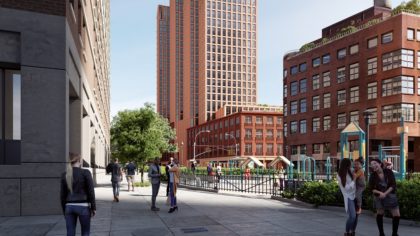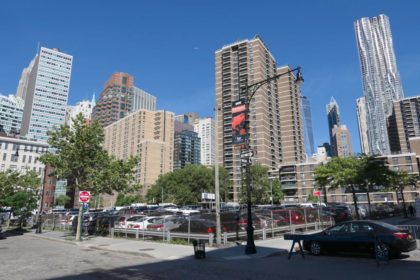Neighbors organizing (and suing) to fight 250 Water plans
The Seaport Coalition, the group of neighbors that has been fighting the Howard Hughes Corporation’s plans for developing the large swath of the Seaport historic district at 250 Water, is circulating a petition now in advance of Monday’s CB1 meeting. You can sign it here and read more for a fuller explanation.
After the Landmarks Commission approved the latest rendition for the buildings at 250 Water, the developer started the city’s land use permit process, and the first stop is Community Board 1’s Land Use Committee meeting on Monday at 6p. The petition will be read aloud there as one piece of the public hearing. Here’s an excerpt:
“The Howard Hughes Corp., aided by an army of lobbyists, is not only pushing through a building three times the allowable height at 250 Water Street, but is now is asking for a 99-year lease to super-size the public land it controls in the Historic District. If approved, this would set the stage for more zoning-busting building in this tiny District.
“In 2015 the National Historic Trust placed the South Street Seaport Historic District on its endangered list. This prescient action anticipated that HHC would seek the approvals needed for what it calls “monopoly-like control” of the Seaport…Our Seaport Coalition welcomes any development at 250 Water Street that conforms with the existing zoning and Seaport Working Group guidelines and principles.”
The coalition has also filed suit last month against the Landmarks Commission, with representation from Michael Gruen, “an experienced land-use attorney who has a proven track record of litigating against the city and state in important preservation battles” as reported in The Village Sun. Their suit argues that the commission should have never granted a certificate of appropriateness for a the project, which is “grossly out-of-scale and clearly inappropriate.”
The developer’s plan for the site has been reduced in size and bulk a bit since its first presentation in January, but it is still wildly out of scale with not just the neighborhood but the allowable zoning heights at that site. It’s currently a parking lot — and has been for decades — but has a 120-foot height limit as part of a deal worked out years ago to encourage development at that site. HHC’s plans call for 324-foot-high buildings with 270 residential units, 70 of which will be designated as affordable.
A spokesman for HHC sent a comment, noting that their project will “transform the parking lot at 250 Water Street into a nearly billion-dollar investment that includes the area’s most significant affordable housing in decades and provides critical funding for the South Street Seaport Museum.” He added that the company was confident the “out-of-touch” lawsuit would be dismissed since it was “nothing more than a desperate attempt on behalf of a handful of project opponents, many of whom are more worried about protecting their views than historic preservation — and some who even think a large tow pound is appropriate for the site in order to protect their views.”
















250 Water Street ULURP
CB1 public hearing June 14 (up to 2 minutes per speaker)
Written comment accepted until July 9 bit.ly/250WaterComment
CB1 LandUse Committee will draft a resolution on July 12
CB1 full board will vote on a final resolution July 27
(then 30 day MBPO review)
They should fight it. Quote from recent NY Times article:
“Ms. Malvern points out that the lot has been home to three mercury thermometer factories, a chemical company and a gas station. It has elemental mercury beneath it, which, when vaporized, can cause brain damage and is particularly dangerous to children. Howard Hughes plans to start remediation next year through the state’s voluntary Brownfield Cleanup Program.”
I would not allow my children within 1000 feet of that site if remediation plan moves forward.
Oh my god! They want to build tall buildings here, in New York City? The audacity.
In all seriousness: this City desperately needs more housing, both market rate and affordable. This kind of reactionary NIMBYism is a perpetual impediment to achieving that. The Times article points out that the existing tow pound is a result of appeasing NIMBY opposition who wanted to preserve their precious waterfront views. I can’t help but wonder how much of the energy behind this fight comes from similarly selfish interests – aesthetic, financial, etc. I am very much in favor of this development. The more housing, the better.
Not if you literally live next door and have children attending school adjacent to the site, with Mercury and noise exposure
The City needs more housing and the seaport needs the revenue. I do not like this brand of suburban rejection of development, especially on a open lot. I echo everything Ben says above.
Patrick and Ben. I suppose you do not know that unfortunately there is a brand new much needed elementary school across the street. I don’t think you would want your children exposed to what’s under that ground. This is also a block from entrance and exit to Brooklyn Bridge. I do not think the block needs more congestion. If the entire building was affordable housing you may be able to persuade me. In this corrupt town of ours you know anyone who knows anyone in government will be residing in those very few affordable apartments. Why don’t they model their project after Southbridge’s small buildings and make them all affordable housing.
.
Karen – the proposal comes with an eight-figure environmental remediation plan. I am not sure how the children would be exposed to anything. I also don’t agree that congestion is a valid concern in general. There are already too many cars in NYC in my opinion, and the solution to that problem is not “less housing.” But even accepting that premise, how can you be sure there will be more traffic compared to that caused by the tow pound, much less so much more as to justify scuttling the creation of hundreds of extremely necessary new housing units (many of which will be affordable)?
I guess people won’t care about the effects of the mercury clean-up, nor the violation of the historic district height restriction because of NIMBYism, or they are just not New Yorkers. Travel the world, and learn how other countries plan, preserve and restore the surroundings of their historic landmark for future generations. We definitely need more affordable housing, but we don’t force build it anywhere with vacant land, especially right next to a designated national historical monument.
Please be civil and properly build something that is appropriate over the 250 water parking lot, and abide by the historic zone height restriction.
I agree with Tom. I am so sick of the cutesy acronym NIMBY that is supposed to stop all discussion of an issue and shame people that don’t agree with them about what is right for their community.
The building is obviously too tall for a lowrise historic district as it was zoned. It will permanently destroy the seaport district.
Shame on the Seaport Museum. They should be in the frontlines opposing this debacle and help preserve the Seaport. Find funding elsewhere for the museum! Also, Howard Hughes is using the promise of a few floors of “affordable housing” as a Trojan horse to push thru a huge building that is mostly luxury appartments.
Attempts to develop South Street Seaport have been a series of misguided failures over the last three decades. First they tried the theme park approach by replicating the success of waterfront tourist malls in other cities ( i.e. Baltimore, Boston ) filled with resort souvenir shops. Then the chain stores arrived followed by various lowbrow- middlebrow bars and restaurants. Sadly since the fish market finally departed SSS had lost its vestige of authenticity. Even the Peking has retired!
Now it’s nothing more than a real estate brand waiting to be exploited to the fullest.
Pretty soon it will mirror the glistening glassy towers across the river, finally we are catching up with Brooklyn!
I’m trying to find out what happened at the land-use and zoning committee meeting on July 12. Was there a vote and what was the result? Thank you!
You can watch on YouTube. I usually get to it eventually…
https://www.youtube.com/watch?v=ginCQuH0NYI